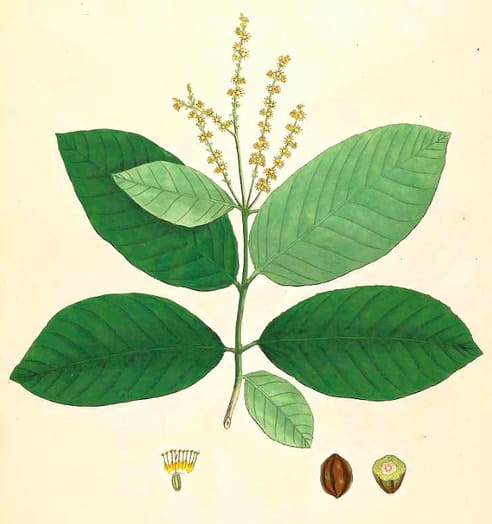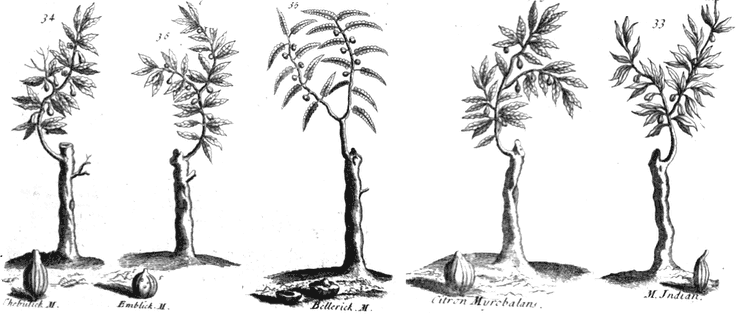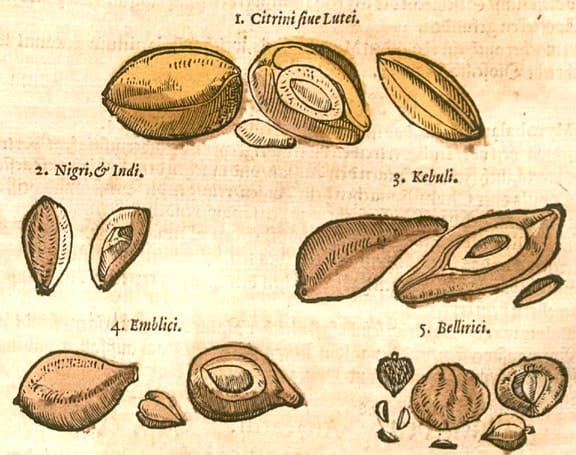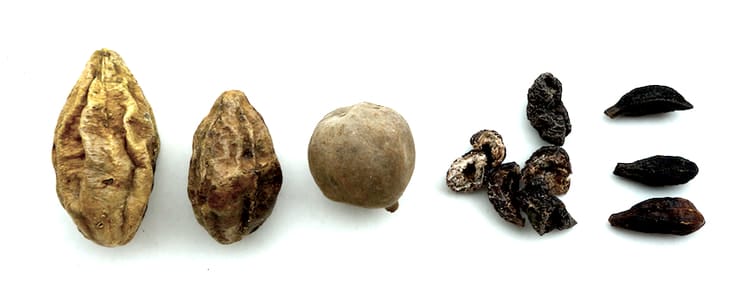Myrobalan, ChebulaHaritaki (Ayurveda)Kadukkai (Siddha) He Zi 诃子 (TCM) Halela (Unani) A Ru Ra ཨ་རུ་ར (Tibetan) |

|
 Chebulic Myrobalan
Chebulic MyrobalanRoxburgh, W., Plants of the coast of Coromandel (1795-1819)
 Chebulic, Emblic, Belleric, Citrine (Yellow) and Indian (Black) Myrobalan
Chebulic, Emblic, Belleric, Citrine (Yellow) and Indian (Black) MyrobalanA Complete History of Drugs, Pomet, London, 1748

1. Yellow (Citrine) Myrobalan
2. Black (Indian, Nigrum) Myroabalan
3. Chebulic Myrobalan
4. Emblic Myrobalan
5. Belleric Myrobalan
Krauterbuch, Lonitzer, 1578
 Left to Right: Yellow Myrobalan, Chebulic Myrobalan, Belleric Myrobalan, Emblic Myrobalan (stoned), Black Myrobalan (Adam, 2017)
Left to Right: Yellow Myrobalan, Chebulic Myrobalan, Belleric Myrobalan, Emblic Myrobalan (stoned), Black Myrobalan (Adam, 2017)See also
Myrobalan and the Triphala Formula
Botanical name:
Terminalia chebula
A number of varieties of Chebulic Myrobalan exist, including the Black and Yellow.
Tibetan texts list 8 major types of Chebulic Myrobalan:
- ‘Dry’ type; smaller, thin flesh with many folds, bitter and astringent
- ‘Nectar’ type; yellow with thick flesh, sweet, bitter, astringent
- ‘Fearless’ or ‘Indestructible’ type; long, black with five facets
- ‘Increasing’ type; round like a vase; tastes sweet and astringent
- ‘Long-tipped’ or ‘Pointed’; a long type, tastes sweet, bitter, hot and sour
- ‘Small Black’; dark, few folds; sweet, sour, bitter, hot, astringent (Black Myrobalan of the West)
- ‘Yellow’ type; yellow, has the same tastes as the Black (Yellow Myrobalan of the West)
- ‘All Conquering’ or ‘Victor’-type; has all 6 tastes; best, but said to be unobtainable in modern times.
Avicenna said “Chebulic myrobalan is of various kinds (a) Unripe yellow coloured variety, (b) Indian black variety which is fully ripe and more compact, (c) Kabuli variety which is relatively bigger in size and (d) Chinese variety which is thin and light”.
Parts used:
Fruits, stoned
Chebula should be oblong, large, fleshy, with few wrinkles and dark yellowish-brown
Avicenna noted “The variety which is dark yellow in colour with a tinge of green, compact, stuffy and hard is considered better. Samples of the kabuli variety which are redish in colour, more dense, heavy and which settles down when put in water, are superior. Among the Chinese variety samples bearing a beak like structure are said to be better.”
Temperature & Taste:
Mildly Cool, Dry in Unani; Neutral in TCM. Bitter, Sour
“All types of chebulic myrobalans are cold in the first and dry in the second degree” (Avicenna)
In Ayurveda and Tibetan Medicine, it is regarded as having all tates, or all tastes except Salty.
Classifications:
2F. PURIFYING. 2O. ASTRINGENT. 2P. HEMOSTATIC. 2S. STRENGTHENING
3C. ALEXIPHARMIC. 3D. CORDIALS & CARDIACS.
4a. CEPHALIC. 4b. OPTHALMIC. 4c. CARDIAC. 4e. STOMACHIC. 4g. HEPATIC
Uses:
1. Strengthens and Regulates Qi, Astringes Essence:
-chief medicine to regulate Vata-Air-Qi; increases and regulates Qi while settling Wind.
-Chinese writers noted it to stop excess rising Qi
–Rasayana, increasing all 7 Tissues, Qi and Essence, protecting the Yin, and increasing Longevity
-Impotence and Senility; as an Aphrodisiac and Sexual Restorative
-benefits Conception and has a Fetus-stabilising effect (for use in Restless Fetus disorder)
-benefits Brain and Eyesight
-believed to increase Wisdom, Intelligence and strengthens the Senses (Ayurveda)
-Mental Illness and Depression
-benefits the Heart and may be used for Thirst.
-prolonged taking of the decoction turns the hair black (Ben Cao Gang Mu)
-‘dissolves accumulation of qi resting in the chest and diaphragm’. (Zhen Quan)
2. Separates the Pure from the Impure:
-Chebulic Myrobalan has a special effect to separate the pure from the impure,
-for Melancholy in Unani and Europe.
-“evacuates both the Black Bile and the Phlegm” (Avicenna)
-Tumors, Cancer, Rheumatism, chronic skin diseases, as well as various other obstinate and chronic disorders.
3. Astringes to Stop Leakage:
-Diarrhea, Dysentery, Leukorrhea;
-Prolapses and Hernia
-Excess Perspiration.
-Incontinence (Zhen Quan)
-Varicosities, Hemorrhoids and Hernias.
-‘stops vaginal bleeding during pregnancy and treats threatened abortion’. (Da Ming)
4. Benefits the Lungs and Throat, Stops Cough:
-Hoarseness of the Throat or Voice, Cough; also Asthma.
-chronic Cough, Asthma with debility in which case it astringes the Lung energy to stop Cough.
-‘good for treating coughing with phlegm accumulation and inflamed throat’. (Su Song)
-‘pacifies acute Asthma’ (Da Ming)
-it can be held in the mouth and the saliva swallowed for acute sore throat. (Ben Cao Gang Mu)
5. Strengthens Stomach, Benefits Digestion:
-benefits Digestion and Assimilation, and improves gastro-intestinal motility
-Obesity, Malabsorption, Anorexia, Indigestion, Poor Appetite and Abdominal distention
-good for Chronic Constipation.
6. Clears Damp, Promotes Urine:
-Dysuria, Strangury, Gravel, Stones, Edema and Ascites, as well as Scrotal Enlargement.
-obstinate Urinary diseases which includes Diabetes. (Ayurveda)
7. Clears Heat and Toxin:
-Fevers including Periodic Fevers; also Erysipelas
-to bring down pathogenic Heat in Fever (Buddhist classic)
-‘brings down the ascending Fire’. (Zhu Zhen Heng)
8. Kills Worms and Parasites.
9. Externally:
-applied to Chronic Ulcers and bleeding Piles
-as a gargle for mouth Ulcers and Sores
-used as a tooth powder for Tooth Cares and Swollen, Bleeding and ulcerated Gums
-ashes mixed with oil or butter to Sores
-crushed in Rose water or steeped in water overnight and applied to the eyes for heat, redness and tearing of the Eyes
-decoction is used as a wash for Leukorrhea and Vaginitis
-applied to Apathae
-“pain in vagina of a woman in puerperium” (TCM: Da Ming)
Dose:
Decoction: 3–9 grams
Powder: 1–3 grams
According to traditional texts:
1. It is chewed to promote digestion
2. Made into a paste (with water or Ghee) to promote bowel movement
3. When boiled it is astringent and constipating
4. after stir-frying, it alleviates all 3 Dosas (Wind, Bile and Phlegm)
Vehicles:
As a health tonic, different vehicles are recommended in different seasons:
1. In Rainy season, take with Salt
2. In Autumn, with an equal amount of Sugar
3. With Ginger in the first part of Winter
4. With Long Pepper in the second part of Winter
5. With Treacle in the Summer
6. In Spring, take with Honey
7. It alleviates Kapha/Phlegm when taken with Salt
8. It alleviates Pitta/Bile, take with Sugar
9. It alleviates Vata/Wind when taken with Ghee
10. It allevaites all diseases if taken with Jaggery
Substitutes:
1. Emblic and Belleric Myrobalan
2. Pomegranate rind (Unani, Avicenna)
3. Oak Galls (Waring)
Correctives:
1. Honey
2. Hot Water (Unani)
3. Almond oil or Ghee
4. Jujube; Sebesten
5. Jaggery
6. Persian Manna (Alhagi)
7. Because they are drying and binding, they were often corrected with Fat broths, or Honey of Raisins, Pulp of Raisins, Cassia Fistula, Manna, Tamarind or some other moistening, lubricating medicine.
8. They are also stopped from being obstructing if a little purgative such as Aloe, Rhubarb or Scammony is added. These then can be used to help open obstructions and purge the Humors.
9. ‘That they offend not the Stomach being stopped, they may be infused in Oil of Sweet Almonds, and rubbed with ones hands, and then dried’. (Pemell)
10. In Ayurveda, they are corrected by being mixed with Honey and Ghee. In Unani, Honey and Almond oil are combined. These form a typical base for many Triphala-based Electuary-style medicines.
Comment
1. The Myrobalans are some of the important medicines in all Traditional Medicine systems except TCM where only Chebulic Myrobalan is used, and that, sparingly. The special thing about these fruits is that they are regulators, and when used together, they can balance and regulate the Humors. Each has a regulatory effect on one of the Humors: Chebula for Wind; Emblic and Yellow Myrobalan for Blood and Bile; Belleric for Phlegm; Black Myrobalan for Melancholy.
2. The three main Myrobalans: Chebulic, Emblic and Belleric, when used together form Triphala, the Three Fruits. These are both a household remedy and the basis for some of the most complex formulas of Traditional Medicine intended to treat some of the most obstinate diseases.
3. There are a great many Myrobalan based formulas used in Traditional Medicine. These are called Triphala in Ayurveda, Itrafal in Unani and Tryphera in the West.
4. Taken in Infusion, they only purge; in Decoction, they purge and bind (purging more); the Powder purges and binds (binds more).
5. Buddhist texts state that when worn on the skin they can treat all diseases.
Preparation:
1. Scorched Chebula:
If scorched a little, they bind only.
Roasted Chebula was said to be best when used in people with Qi deficiency. (Ben Cao Gang Mu)
Avicenna said when fried in oil, they cause constipation (ie. its enhances their astringent nature)
2. Candied Chebula:
They are sometimes candied which makes them more tonifying. (West)
3. Wine-prepared Chebula:
Soak the fruit in wine, then steam and dry.
Main Combinations:
Triphala
1. Diarrhea:
i. Chebula with Galls can be combined as an astringent
ii. from Cold, weak Kidneys, Chebula with Nutmeg (TCM)
iii. Chebula with a little Rosemary and Rhubarb (Parkinson)
iv. or Dysentery, Chebula, Rhubarb (1 dram ea.), Red Coral (1 scruple)
2. Gastroenteritis, Dysentery, decoct Chebula (4 parts), Coriander seed, Dill seed (2 parts each), Celery seed, Ginger, Licorice
3. Colitis, Gastroenteritis, Chebula with Coptis Huang Lian, Costus (Mu Xiang)
4. Constipation:
i. As a mild Laxative, 2 or 3 fruits made into a paste and taken with Rock Salt
ii. Chebula (stone removed) 15 grams, decoct in 400 mls of water down to 100 mls. Take half–1 cup before bed. (Siddha)
iii. from Vata/ Wind, Chebula with Psyllium, Hemp seed
iv. from Pitta/Bile, Chebula with Picrorhiza, Emblic Myrobalan
v. from Kapha/Phlegm, Chebula with Belleric Myrobalan, Long Pepper
vi. Chebula with Cassia Fistula pulp, Picrorhiza, Emblic Myrobalan, Turbith (equal parts), prepared as a decoction.
5. Indigestion, Bloating, Chebula with Cardamon, Fennel seed, Celery seed
6. Cough:
i. “It is good for treating coughing with phlegm accumulation and inflamed throat. Hold three pieces of the dmg in the mouth. It works perfectly”. (TCM: Su Song)
ii. chronic Cough, Chebula with Almond kernel (Xing Ren), fresh Ginger (TCM)
iii. Cough and Asthma, Chebula with Adhatoda, Tylophora, Long Pepper (Ayurveda)
iv. Cough from Lung Qi deficiency, Chebula with Ginseng (Li Shi Zhen)
7. Loss of Voice:
i. Chebula, Clove, Tabasheer, Licorice
ii. Chebula with Platycodon Jie Geng, Licorice (TCM)
8. To separate the pure from the impure, Chebula can be taken with Agrimony and Rhubarb (West)
9. To regulate the flow of Qi in the body, stop Wind, and anchor the Qi in the lower abdomen (‘Dan Tian‘) Chebula can be taken with Aloeswood, Cinnamon, Nutmeg and Clove.
10. To stop rising Qi, Chebula with Citrus Ju Pi and Magnolia Hou Po (Li Shi Zhen)
11. Sciatica, Lumbago:
i. Chebula, Comfrey
ii. Chebula with Bdellium, Turmeric, Frankincense, Cinnamon, Clove
12. Anal Prolapse:
i. Chebula, Bupleurum Chai Hu, Atractylodes Bai Zhu
ii. Chebula with Poppy capsule, Orange peel (Ju Pi), Ginger (Gan Jiang)
13. To increase Qi and strengthen the Brain, Heart and Stomach, confected Chebula can be taken with Withania
14. As a Brain and Heart stimulant and tonic, Black and Chebulic Myrobalans, Frankincense, Tabasheer, Sandalwood, Chicory seed, Pepper, Ginger (as in Electuary of Chebula of Unani)
15. Diabetes:
i. Chebula, Myrrh
ii. Chebula, Shilajit
16. Poor Eyesight, confected Chebula, conserve of Eyebright, conserve of Betony, conserve of Rosemary, Elecampane (Wirtzung)
17. Cataract, Yellow, Chebulic and Black Myrobalans with Aloe, Stoechas, Wormwood, Agaric, Rhubarb, Asarum, Mastic, Bdellium, Colocynth (as in Cataract Pills of Unani)
18. Dizziness, preserved Chebula and Emblic Myrobalan, preserved Nutmegs, with Currants, Licorice, Bugloss water, Honey of Roses, Cinnamon
19. Ulcers, apply Chebula with Mastic to dry and heal them
Major Formulas:
Chebula and Bdellium Pills (Haritakyadi Guggulu)
Kaisor Guggulu (Bdellium Youthful Pill) (Ayurveda)
Nutmeg Powder (Jatiphaladi Churna) (Ayurveda)
Decoction of Myrobalan (Mesue)
Syrup of Chebulic Myrobalan
Magisterial Imperial Pills
Pills of Chebulic Myrobalan
Pills of Fumitory (Avicenna)
Pills for Migraine (Galen)
Pills for Mixed Humors (Mesue)
‘Pills without which I would not be’ (Nicholas)
Arabian Pills (Nicholas)
Confection for Dizziness and Vertigo
Electuary of Life (Arnold de Villa Nova)
Electuarium Alcharif (Mesue)
Electuary of Micleta (Nicholas)
Letificans Cooling Electuary (Unani)
Triphala Electuary of Raisins (Unani)
Triphera of Dodder of Thyme (Mesue)
Triphala Electuary of Dodder (Unani)
Triphala Electuary of Fennel Seeds (Unani)
Triphala Electuary for Epilepsy (Itrifal Zabeeb)
Triphera Persica (Mesue)
Triphera of the Saracens (Triphera Saracenica Magna)
Triphera Minor (Triphera Phoenonis) (Mesue)
Triphala Electuary Lesser (Unani)
Triphala Electuary Greater (Unani)
Triphala Electuary to Purge Phlegm and Black Bile
Chebula 7 (A ru bdun pa)
Chebula 10 (A Ru 10) (Tibetan)
Aloeswood 18 (A Ru 17) (Tibetan)
Chebula 18 (A Ru 18) (Tibetan)
Chebula 18 for Incontinence (Gcin snyi a ru 18) (Tibetan)
Aloeswood 9 (A gar dgu pa) (Tibetan)
Auscpicious Conqueror (Bkra shis rnam rgyal) (Tibetan)
Frankincense 10 (Spos dkar 10) (Tibetan)
Increase Awareness Pills (Tibetan)
Nux Vomica 15 (Ko byi bcu lnga) (Tibetan)
Podophyllum 25 (‘Ol se nyer lnga) (Tibetan)
Rhododendron 18 (Dwa lis bco brgyad) (Tibetan)
Supreme 25 (Bla med nyer lnga)
Zhen Ren Yang Zang Tang (TCM)
Cautions:
1. Use carefully in Pregnancy
2. Careful in Yin deficiency and excess Heat conditions
3. Should not be used in acute Cough (Li Shi Zhen)
CAUTIONS FOR THE MYROBALANS IN GENERAL:
1. Mesue said the only deleterious effect of the Myrobalans was their potential to create obstruction. This is why they are regularly mixed with Ghee or Oil and Honey in Ayurveda and Unani. They are also used with medicines to prevent likelihood of obstruction such as Stoechas, Indian Spikenard, Ginger or Pepper etc.
2. Pemell said they should not be used in Obstruction or Fever. They are sometimes used in formulas in these cases with appropriate medicines.
Toxicity:
5000 mg/kg of hydroalcoholic of T. chebula is safe in acute toxicity studies.
In Sub-acute toxicity, over 2700 mg/kg was safe.
Main Preparations used:
Confected Chebula
|
‘Dutt (Hindu Materia Medica) informs us that Chebulic myrobalans, in Sanskrit Haritaki, Abhaya, and Pathya were highly extolled by the ancient Hindus as a powerful alterative and tonic. They have received the names of Pranada or life-giver, Sudha or nectar, Bhishakpriya or Physician’s favourite, and so forth.* A mythological origin has also been attributed to the tree. “It is said that when Indra was drinking nectar in heaven a drop of the fluid fell on the earth and produced the plant.” Sanskrit writers describe seven varieties of Haritaki, which however are nothing more than the same fruit in different stages of maturity. Very large fruit are considered particularly valuable, and fetch a fancy price. Chebulic myrobalans are considered to be laxative, stomachic, tonic, and alterative. They are prescribed alone or in combination with Emblic and Belleric myrobalans in a vast number of diseases, chiefly those affecting the chest and abdomen. The three myrobalans together are called triphala in Sanskrit (the three fruits). Various original receipts for their administration will be found in Dutt’s Hindu Materia Medica. Myrobalans were known to the early Arabian writers, and through them to the Greek writer Actuarius, who mentions five kinds. Nicolas Myrepsus also notices them. The author of the Makhzan-el-Adwiya, on the subject of Chebulic myrobalans, says that the: very young fruit, about the size of cummin seeds, are called Halileh-i-Zira; when about the size of a grain of barley, Halileh-i-jawi; when of the size of a raisin, Halileh-i-Zangi or Halileh- i-Hindi; when half arrived at maturity and yellowish, Halileh- i-chini; when still further advanced, Halileh-i-asfar; and lastly, when quite mature, Halileh-i-Kabuli. Of these six varieties of Chebulic myrobalans the first, third, and last only are in general use, but the others are occasionally to be met with in the Bombay shops. The |
Mahometans, like the Hindus, attribute a great many fanciful properties to the drug; shortly, we may say, that the ripe fruit is chiefly used as a purgative, and is considered to remove bile, phlegm, and adust bile; it should be combined with aromatics, such as fennel seeds, caraways, &c. The unripe fruit (Halileh-i-Hindi) is most valued on account of its astringent and aperient properties, and is a useful medicine in dysentery and diarrhoea; it should also be given with aromatics. The first and second kind are supposed to have the same properties as the third in a less degree, and the 4th and 5th the same as the 6th in a less degree. The best way of administering myrobalans is to make them into a conserve with honey or sugar; two or three of the mature fruit are a sufficient purgative for an adult. Ainslie notices their use as an application to aphthae. In the Pharmacopoeia of India Dr. Waring mentions his having found six of the mature fruit an efficient and safe purgative, producing four or five copious stools, unattended by griping, nausea or other ill effects; probably those used by him were not of the largest kind. Twining (Diseases of Bengal, Vol. I.,p. 407,) speaks very favourably of the immature fruit as a tonic and aperient in enlargements of the abdominal viscera. I have found them a useful medicine in diarrhoea and dysentery, given in doses of a drachm twice a day. Roxburgh tells us that the tender leaves, while scarce unfolded, are said to be punctured by an insect, and its eggs deposited therein, which by the extravasation of the sap, become enlarged into hollow galls of various shapes and sizes, but rarely exceeding an inch in diameter. They are powerfully astringent, and make as good ink as oak galls. They also yield the chintz painters on the coast of Coromandel their best and most durable yellow. They are called by the Tamils Kadu-cai, and by the Telingas Aldi-cai, and are very like the Faba Bengal-ensis of our Materia Medica (Fl. Ind. II., 435.) (Vegetable Materia Medica of Western India, Dymock, 1885) |
